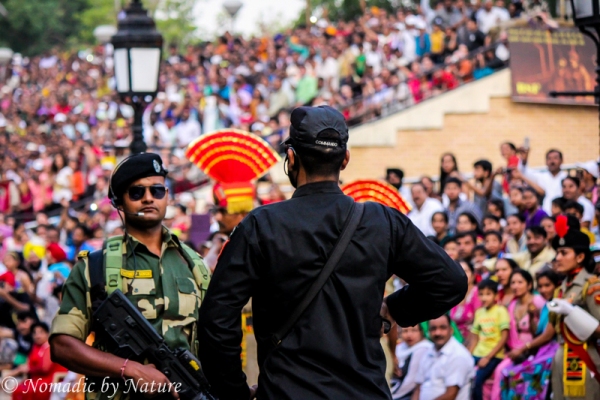
Wagah Border ceremony: Choose one identity over another
It is a border constructed of hate, but bridged by culture, cuisine, legends, and the love of families split apart.
For almost 3,000 kilometres, the border fence between Pakistan and India runs from the sea to the great mountains of the north. It is lit by 150,000 flood lights, which glow bright orange from space, scarring the solace of the desert and the shared cultural history of the millions who live in it.
It is broken in the hinterlands of Punjab by the Wagah Border Crossing. While the border itself is a product of the violent geo-political dynamic between the countries, this passage across it undermines its absoluteness and highlights its complexity.

The border separates the two countries, bisecting a culture and its people – governed by two sworn enemies yet also ancient relatives. A sliver of land exists between each county’s gate, and in this stateless purgatory, each nation ironically flies their flag. Every day at dawn, the gates are flung open to raise each flag, and then again at dusk to lower them for the night. These glimpsing moments of trust are approached with both extreme ceremony and caution, worthy of the international spectacle it has become.

Arriving for the first time just before dusk on the Pakistani side, other attendees look like they have come to a sporting match, dressed in the green and white of the Pakistani flag. As the stadium seating starts filling, the men separate from the women on opposite sides of the trans-national highway, and it becomes clear that the border fence is not the only divide in the crowd. Giant concert-sized speakers begin blasting Pakistani pop music, and men with enormous Pakistani flags run along the road between the stands to the crowd’s cheers.

Then unceremoniously, the music is cut and the crowd silences, and speakers from across the border blast Bollywood pop to the roar of an unseen crowd behind the gates chanting,
“Hindustan, Hindustan!”
It becomes apparent that the whole ceremony is a practiced ritual between the two sides, once described as “carefully choreographed contempt”.

However, the festive mood is interrupted by Special Forces brandishing arm cannons who take positions on the border gate, mirrored by their counterparts on the other side with the same bushy moustaches in a message of mutually assured destruction. It reminds everyone that beyond the short ceremony taking place, the militaries of both nations are pointing nuclear weapons at each other.

Between the ping-ponging of pop music across the border, the gender segregated stands, and the militarisation of the ceremony for civilians, another division emerges. It is the Pakistani elite, ushered into VIP private seating in the front row, men and women sitting together. Men in kurtas with enormous pot bellies, and women with designer sunglasses but without hijabs, brandishing smartphones, and cute little Pakistani flags painted on their faces.

The diversity of division begs the question, why has everyone chosen to direct their attention only to the nationalistic division, during this ceremony when all are front and centre?
The great Nobel Laureate, Amartya Sen’s ideas seem so salient. He writes about the multiple identities that we all hold based on the myriad of roles we fill in life, as citizens, professionals, mothers, or brothers, and notes that each can be associated with different perspectives and even values.

I strive to understand why Pakistani women sit at the ceremony with sons on their lap as a Pakistani, chanting slogans against Indian mothers on the other side of the fence, instead of conspiring with them to unite against any hatred that might endanger children on either side of the fence.
Why do the masses in the stands not form an alliance to chant against the privileged class in the front, and how come the small business owners on either side of the fence fail to bond to advocate for easier trade access across the fence?

Why do we choose one identity over another in any given situation?
Men dressed in ornate ceremonial military uniforms from the countries’ shared colonial era emerge in formation, and the gates open like theatre curtains, revealing the same formation on the Indian side. Then with the dramatic elegance of the West Side Story, men march, stamp, and shake their fists at each other, in a coordinated ballet of anger worthy of a Mexican wrestling arena.
Upon reaching the gate, the two sides shake hands briefly, lower their respective flags in unison, and slam the gates shut with bellowing metallic booms.

Having had shared the same experience in the same place, the Indians and Pakistanis depart down the same dusty desert road in opposite directions, relaying the highlights of the event in almost the same language. It is a border constructed of hate, but bridged by culture, cuisine, legends, and the love of families split apart by it.

Five months after I visited the ceremony, a suicide bomber killed around 55 people and injured 120, highlighting the contemporary conflict that resulted in the border itself. The Wagah Border Crossing ceremony is a glimmer of hope in the level of cooperation it shows, which is possible between the two countries’ militaries that share a past, and may still have a chance to share a future.
It seems to bring the two sides just a little closer, and to this regard, one wonders if and when the Wagah Crossing of gender and class empowerment will emerge in these two neighbouring countries.
All photos: Mike McCaffrey
The original piece appeared here.



COMMENTS (43)
Comments are moderated and generally will be posted if they are on-topic and not abusive.
For more information, please see our Comments FAQ